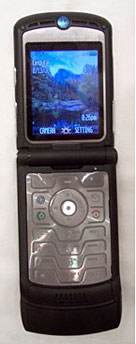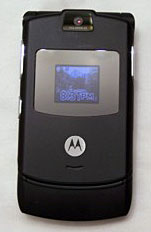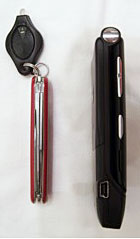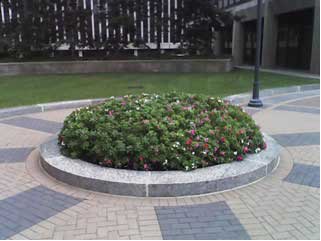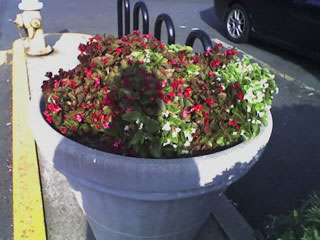
|
||||||||||
The V3 includes only 5 MB of RAM, which isn’t much by today’s standard. However, the camera’s low resolution means lots of pictures will fit in RAM. If you’re heavy into Java games, though, you may have to be selective. Personally, I’ve never come close to hitting the RAM limit, but I don’t normally use games on my phone. Phone Features and Reception I tested the Cingular branded, worldwide quad-band (850/900/1800/1900 MHz) GSM/GPRS version, but Motorola also has a CDMA version in the V3C model. Although the RAZR lacks an external antenna, its reception is consistently excellent. Unbeknown to most users, the V3 has a very small, covered external antenna connector on its back lower left. When using a headset, I’ve noticed that the reception tends to be better with the phone opened as opposed to closed. I have used the RAZR all over the Eastern US and in most of Northern Europe with no problems to note. Both data and voice proved highly reliable on all my travels. Sound quality and volume both with the handset and through a headset are excellent. I can use both in heavy traffic without difficulty. The RAZR sports a host of use-enhancing features. It supports WAP 2.0 for a quality web browsing experience. Speech recognition enables voice dialing, and the integrated speakerphone provides hands-free use right out of the box. The speakerphone works great, with clear inbound and outbound conversation at comfortable volume levels. Using GPRS, the V3 can download programs, images, videos, ringtones, etc. GPRS isn’t known for speed, the V3 providing about 40 kbps (slow dialup speed) on a good day, but I found it adequate for the common data tasks on the RAZR The V3C with CDMA 1x supports the higher speed EVDO protocol. The V3 also has a nice vibrating alert feature. While vibrating alerts eat more battery, they are great for meetings and other gatherings when you don’t want a ringer going. The vibrations are adequate when the phone is touching your body directly, like a shirt or back pocket, but isn’t strong enough to be felt if it is mixed in with other stuff in a front pants pocket or even in a light jacket. Display, Gaming and Multimedia Another of the endearing quality of the RAZR is its large, 2.2 inch, color TFT internal display. It sports 176 x 220 pixels, up to 260K Color, and keeps things crisp with a graphics accelerator. It also supports 9 text lines. Its incorporation into the RAZR’s flat form actually makes it appear proportionally larger than its rivals. The high quality of the screen make the V3 a pleasure to use, and also facilitates the comfortable viewing of pictures and videos. One downside, though, is that it can be difficult to read in bright sunlight. The V3 also possesses an external display that supports 96 x 80 pixels with 4k CSN colors and 4 Lines of text or icons. When the RAZR is folded closed and not connected to a call, the outside display shows the user’s wallpaper plus the time and service status. When an incoming call or message arrives, the outside screen shows the incoming number or message notice. When the RAZR opens, the outside display changes to the provider’s logo by default. When the RAZR is closed during a call, the outside display tracks the call time if the user so chooses. That’s a lot for a small display, and it all works very well. The RAZR’s gaming system supports 3D Java applications. It ships with a Bejeweled demo and a slideshow program embedded, and has 5 MB of space for additional downloads. Bejeweled is my favorite handheld game and it plays well on the V3. The V3 uses polyphonic MP3 ringtones played over a 22 KHz polyphonic speaker that supports 22 chords. This opens a host of possibilities for ringtones, including music and human speech. Note the 22 KHz requirement. If you wish to play standard desktop 44 KHz MP3s on the RAZR, they must be converted to work on the phone. The RAZR incorporates a Picture Phonebook in case you have difficulty remembering who goes with what name. The built-in camera makes accumulating the pictures easy. One of the possible phone book displays is optimized for this feature. The V3 also records and plays 3GP video clips with sound. The graphics accelerator provides smooth video performance. Although the screen looks great, at 2.2 inches it isn’t exactly a Cinemascope experience.
Bluetooth Generally, small electronic devices use Class 2 Bluetooth, which has about a 30 foot range. The RAZR V3 ups the ante by using Class 1 Bluetooth with a range of about 100 ft (not legal outdoors in France). This sounds good on the surface, but it turns out that virtually no other handheld device uses Class 1. This limits the range with those devices to about 30 feet anyway. Also, Class 1 BT eats up significantly more power. This showed up in testing as significantly shorter battery life under active BT operation. The good news is that the BT stack in the V3 supports OBEX file transfers, dial-up networking (DUN), and headsets. The former allows the transfer of sound files, pictures, videos, addresses, calendar items, or bookmarks. The DUN allows the RAZR to be used as a modem with its GPRS connection. The DUN worked perfectly with the Dell Axim X50v both in the US and Europe, for both email and data transfer. I used it consistently to get the weather on my X50v while traveling. I was able to pair the V3 to my Dell Axim X50v and my desktop Windows XP SP2 computer. I used it with the Logitech Mobile Freedom Bluetooth Headset, i.Tech Arrow I Bluetooth Headset, and the Parrot DriveBlue hands-free in-car setup. Pairing proved easy for all of them. Once a device has been paired initially, if BT is enabled on the RAZR first on subsequent connections, it will automatically connect with the device when it is powered up. Bottom line is that I almost always use the RAZR with the Logitech headset and am very happy with that combination. The only downside is that it eats up the RAZR’s battery much faster than without the BT active. Battery Life Motorola says that the V3 comes with a 680 mAh Li-ion battery. However, the battery in my black RAZR is 710 mAh. Hmmm. Motorola claims a talk time of approximately 200 to 430 minutes, and a standby time up to approximately 180 to 290 hours. The excellent battery figures first attracted me to the phone over a few others. In reality, many things affect battery life. GSM uses a smart power management system that automatically uses less power for strong signals and more power for weaker ones. So, if you use the V3 mostly in a strong-signal area (like most of Europe), your battery life will be better than someone in rural America. Lower frequencies penetrate building walls better than higher ones, so if your carrier uses a higher frequency in your area then your signal and battery life will probably suffer inside buildings. Building construction and the location you lay the phone in a car greatly affect the signal strength you will see. All that said, my experience has been that the lower end of Motorola’s estimates will be more of the norm, maybe even a bit optimistic for average users unless you live under a cell tower. Now, if you really want to hammer your battery, use Bluetooth for a while. My conservative estimate would be that active BT use (e.g., actively talking over a BT headset) will cut your battery life by over 50%. I accept that as the cost of doing business, but I also have a plug-in headset as well for a backup. If you travel, take your charger with you if you will be talking for an hour or two using BT. This makes me wonder even more why Motorola chose BT Class 1 for the RAZR They have gone back to Class 2 BT for successor phones. Software The OS is the typical proprietary Motorola with a Java wrapper on it. That has strengths and weaknesses. The strength is that the Java wrapper will run almost all J2ME mobile applications like Opera Mini 2.0, and the Java can be modified by clever users. The downside would be the inability to run Symbian apps on the phone. The V3’s menu system is far from any standard, but it isn’t as inscrutable as some claim. I learned the system very quickly. It can also be individualized with user-customizable softkey functions, main menu layout, and keyboard shortcuts. The phone support software is top-notch. Recent calls may be recalled by incoming or outgoing. Missed calls bring a banner to the screen, then appear as uncompleted incoming calls. All completed calls, ingoing and outgoing, have a checkmark next to them. For quick dialing, simply press the connect key for a list of the 10 most recent outgoing calls. If a call fails, the V3 offers the option to redial. When it connects on a redial, the phone rings to notify you of the connection. The RAZR keeps track of your cumulative talk times (incoming and received), data times (local and DUN), KBytes transferred, as well as total for the life of the device (until reset). So what I do is reset the recent talk and data tracking to zero at the beginning of my service month, then the phone tracks my usage for the current month. It won’t be exact to the carrier’s records, but it will be close enough to keep you out of trouble. This is a great feature. The only major shortcoming comes in the phonebook. Out of the box, it only jumps to the first name starting with the first letter you type. There’s no search capability, and no multiple entries per name. So, if your friends have multiple numbers (home, work, mobile), then they will have multiple phonebook entries. With a capacity of up to 1000 entries in RAM plus up to 250 on the SIM card, that’s a lot of arrowing up and down through entries without search capability. What was Motorola thinking? The good news is that you can group callers together into profiles, tailoring rings to groups. This can be a nice way to know if a family member or business associate is calling. You can also set an ignore group to remain silent so they never disturb you. Of course, I would never to that… The SMS and MMS support is pretty robust. The messaging system will concatenate long text messages. The manual says it will chain up to 13 text messages, but I’ve never had it connect more that five before giving up. One email account may be programmed into the phone. Performance over GPRS proved satisfactory. Messaging comes preprogrammed to a button on the keyboard for quick access. All the messaging capabilities use the same menu-driven interface. The input system uses iTap, which differs from the standard T9 you usually see on mobile phones. I found the predictive engine quite robust, though those coming from T9 will have a small learning curve on the interface. The predictor learns over time as it observes your input patterns. I found iTap to be a better predictor than most T9 engines I’ve tried. The built-in WAP browser also comes preprogrammed to a button on the keypad. Pressing it loads the browser and connects to the Internet. The browser can be very slow in loading. No data is compressed in the WAP browsing process, so the slowness of GPRS really comes home to roost even on simple WAP pages. I downloaded the free Opera Mini 2.0, which uses a proxy that compresses the WAP 2.0 data. This results in both a faster browsing experience and reduced data charges with your carrier. I highly recommend it. Other features include a basic calendar that supports alarms, a separate alarm clock, a simple calculator/currency converter, online chat capability, and a voice recorder. It supports voice dialing as well for total hands-free operation. Optional Software The V3 box does not contain a data cable or software to connect to the desktop. The suggested software is Motorola Phone Tools by BVRP available over the web for about $29.95 (more with the cable). It allows you to synchronize your phone with MS Outlook in a very simplistic way, plus transfer pictures, videos, and sound files. It will automatically convert files that need conversion (especially sound files) before sending them to the phone. It generally works quite well and should come with the phone. Other brands come with this kind of software in the box or downloadable, but the absence doesn’t seem to have hurt Motorola’s sales. Faint of Heart – Don’t Read This Section I normally wouldn’t include this in a phone review, but I want to bust a myth. Symbian OS fans like to say that the Motorola OS has limited customization. On the contrary, it can be modified beyond your normal phone imagination. I hinted above that the Java aspect opens up possibilities. It turns out that there are folks so dedicated to the Java OS wrapper on Motorola phones that they spend an inordinate amount of time modifying it. Caveat Explorata: MobileTechReview does not endorse any of the following sites, not do we endorse altering the operating system of your phone. This will undoubtedly void your warranty and may cause your gerbil to develop unsightly warts. If you turn your phone into a paper weight, don’t say that we didn’t warn you. That said, these folks have awesome web sites with detailed FAQs. A few of the best are MotoModders, MotoX, TheMotoGuide, HowardForums, and Lord Farkward’s FAQ. With the tools, files, and information from these and other sites, plus the USB drivers from Motorola Phone Tools, you can tailor your V3 to suit your fancy. You might even find a cure for the lack of phonebook searchability. I won’t go into the details here, but there’s a whole modding world out there full of happy, highly-customized campers. After playing with this strange fire, I actually pity the poor Symbian OS owners for the lack of customizability of their phones. So there! Conclusion The Motorola RAZR V3 redefined style for mobile phones and proved a thoroughbred straight out of the gate. After almost two years on the market, it still turns heads, sells better than other phone, and commands a large and loyal following. Motorola followed up with the CDMA V3C, the V3i, V3m and the V3x, all with progressive improvements. Now available in at least three colors in the US (silver, black, and pink), the RAZR V3 still outsells all other competitors, and for good reason. Pros: Cons: Web sites: hellomoto.com, www.cingular.com Pricing: Around $100 with 2 year contract
| ||||||||||
